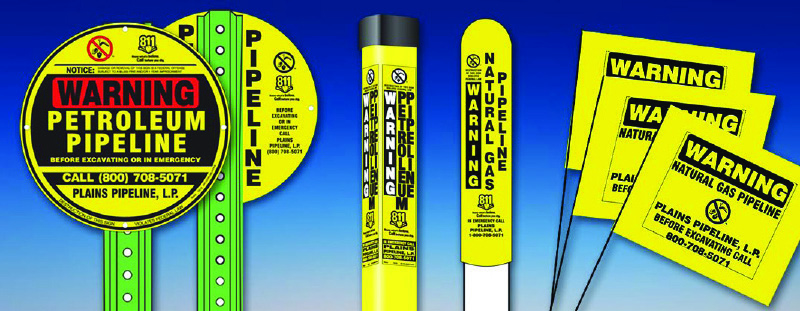Call or Click 811 before you dig. Pipeline Emergency? Call 911, and then call Plains 1-800-708-5071
Before You Dig
This guide was created to help you identify and safely respond to events or abnormal situations involving pipelines and underground utilities. Please ensure that you are familiar with this information.
Excavation is the leading cause of damage to underground utilities. Following basic rules and regulations as well as proper excavation practices prior to digging can significantly reduce the risks associated with excavating near underground utilities. Excavation activities include everything from earth-moving operations to home projects such as building a pool or fence, widening a driveway or planting a tree.
Making the One Call
After proper planning and white lining has occurred, you are required by law to contact 811, “Call Before You Dig,” at least two business days in advance of digging, 48 hours (excluding weekends and holidays), or according to your state’s requirements. This will connect you to your state’s One Call Center. The One Call Center notifies Plains and other pipeline and utility operators in the area of your planned excavation. A representative will be sent free of charge to locate and mark the buried facilities before you dig, as necessary.
You should always wait the required time to allow utility and pipeline representatives to mark the location of lines in the area. In addition, the One Call Center will provide you with a locate request number and a list of companies who will be notified. Keep this information with you on the job site.
When Contacting 811, You Should Provide the One Call Center With the Following:
- Project location and address
- Project description
- Project duration
- Special instructions helpful for marking the site

Pipeline Rights-of-Way
A pipeline right-of-way is a strip of land over and around a pipeline where some of the property owner’s legal rights have been granted to a pipeline company. This also may be referred to as an easement. Rights-of-way and easements provide a permanent, limited interest in the land that enables the pipeline company to operate, test, inspect, repair, maintain, replace and protect one or more pipelines on property owned by others. Generally, the pipeline company’s rights-of-way extend 25 feet from each side of a pipeline unless special conditions exist.
Pipeline Markers
Pipeline markers and warning signs are placed at strategic locations to indicate the presence of buried pipelines. They act as a visual reminder that a pipeline is located in the area.

These markers provide:
- The product transported in the pipeline
- The name of the pipeline operator
- The telephone number where the operator can be reached in an emergency
Encroachment
An encroachment is an infringement of another’s rights or intrusion on another’s property. Pipeline rights-of-way must be kept free from structures and other obstructions, such as trees or shrubs, to provide access to the pipeline for maintenance, ground and aerial inspections, and in the event of an emergency.
If an easement is encroached upon, the encroachment may be removed without compensation or replacement. Please help us to prevent encroachment or pipeline damage by calling 811 to have pipelines marked and rights-of-way staked prior to digging, building, storing or placing anything on or near the right-of-way.
The following are examples of right-of-way encroachments that could be removed without compensation or replacement:
| RESIDENTIAL BUILDINGS | FENCES | PERMANENT STRUCTURES | PATHWAYS |
| COMMERCIAL BUILDINGS | HIGHWAYS OR PUBLIC ROADWAYS | ORNAMENTAL ROCKS | SEISMOGRAPHIC ACTIVITIES |
| PONDS | SHEDS | DRAINAGE TILING | WILDLIFE FEEDERS |
| UTILITY LINES (OVERHEAD OR BURIED) | PARKING LOTS | TREES, BUSHES OR SHRUBS | SIDEWALKS |
| SWIMMING POOLS | DECKS | CANALS | THIRD-PARTY PIPELINES |
How Do You Recognize a Pipeline Release?
LOOK, LISTEN and SMELL for these products. If found, immediately leave the area and report to authorities by calling 911.
LOOK for Releases Around a Pipeline
- Liquid pipeline: Pools of liquid along the pipeline, oily sheen on liquid surfaces or continuous bubbling in wet or flooded areas.
- Liquefied petroleum gas pipeline (LPG, such as propane or butane): A vaporous cloud or fog that travels low to the ground with possible frost formation even in warm weather, dead vegetation and blowing dirt at the release.
- Natural gas pipeline: Dead or discolored plants in an otherwise healthy area of vegetation, frozen ground in warm weather, or blowing dirt near a pipeline as well as fire coming from the ground or fire burning above.
LISTEN for Unusual Sounds
- The sound can range from a quiet hissing to a loud roar, depending on the pressure in the pipeline and the size of the leak.
SMELL for Unexpected Odors
- A crude oil or refined product liquid release can cause an unusual smell or petroleum odor.
- Be aware: some products, such as natural gas or LPG, may not have an odor, although they can contain hydrogen sulfide and are toxic.
In the Event of a Suspected or Detected Leak
- Turn off gas appliances or equipment to eliminate a source of ignition, if safe to do so;
- Leave the area by foot immediately and attempt to stay upwind. Do not try to locate the source of the leak or odor. Try to direct other individuals to leave the area by foot also;
- Call 911 from a safe location. Call your local utility operator and the Plains emergency contact number immediately: 1-800-708-5071
In the Event of a Leak:
- DO NOT come into contact with any escaping liquid or gas.
- DO NOT attempt to operate any pipeline valves yourself.
- DO NOT start motor vehicles or electrical equipment.
- DO NOT use telephones or cell phones in the area of a release – only in a location known to be safe. If inside a home or business, do not pull plugs from electrical outlets or open an automatic garage door.
- DO NOT ring doorbells to notify others of a leak. Knock with your hand to avoid a potential spark from metal knockers.
- DO NOT drive into a leak or vapor cloud while leaving the area.
- DO NOT attempt to extinguish a petroleum product or natural gas fire. Wait for local emergency professionals trained to deal with such emergencies.
How Will Plains Respond in an Emergency?
Plains conducts emergency drills to test its emergency response plans and to practice emergency response activities to help assure an effective response. If a pipeline incident is suspected, Plains will immediately route personnel to the scene to assess the situation and to minimize the impact of an incident. Plains employees will be available to isolate, shut down, or start up any pipeline system facilities and to communicate with local emergency response and public officials.
For more information on our Emergency Response Plans, please email us at [email protected].
